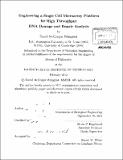| dc.contributor.advisor | Bevin P. Engelward. | en_US |
| dc.contributor.author | Weingeist, David McGregor | en_US |
| dc.contributor.other | Massachusetts Institute of Technology. Dept. of Biological Engineering. | en_US |
| dc.date.accessioned | 2012-07-02T15:43:54Z | |
| dc.date.available | 2012-07-02T15:43:54Z | |
| dc.date.copyright | 2012 | en_US |
| dc.date.issued | 2012 | en_US |
| dc.identifier.uri | http://hdl.handle.net/1721.1/71471 | |
| dc.description | Thesis (Ph. D.)--Massachusetts Institute of Technology, Dept. of Biological Engineering, 2012. | en_US |
| dc.description | Cataloged from PDF version of thesis. | en_US |
| dc.description | Includes bibliographical references. | en_US |
| dc.description.abstract | DNA damage contributes to cancer, aging, and heritable diseases. Ironically, DNA damaging agents are also commonly used in current cancer treatment. We therefore need robust, high throughput, and inexpensive tools for objective, quantitative DNA damage analysis. The single cell gel electrophoresis (comet) assay has become a standard method for DNA damage analysis, however, it is not well suited for use in clinical and epidemiological settings due to issues of low throughput, poor reproducibility, and a laborious image analysis requirement. To overcome these limitations, we applied microfabrication techniques to engineer an arrayed cell comet platform that maximizes the number of analyzable cells and provides spatial encoding for automated imaging and analysis. Additionally, we developed complementary software that eliminates the inherent bias of manual analysis by automatically selecting comets from the defined array. In its 96-well format, the so-called CometChip integrates with high throughput screening technologies, further increasing throughput and removing user error. This improved approach enables multiple cell types, chemical conditions, and repair time points to be assayed in a single gel with improved reproducibility and processing speed, while maintaining the simple protocol and versatility of the comet assay to assess a wide range of DNA damage. Using the CometChip, we evaluated a variety of DNA damaging agents, revealing repair profiles that can be used to gain insight into biological mechanisms of damage sensitivities. We confirmed the ability of the CometChip to identify deficiencies in four major DNA repair pathways, supporting the use of the assay in determining pathway sensitivities that may be useful in guiding treatment strategies that more selectively target cancerous cells and reduce side-effects. We also used the platform to evaluate potential inhibitors of DNA repair, which are emerging as promising adjuvants in cancer management. Taken together, the CometChip enables high throughput genotoxic evaluation of chemical exposures, discovery of novel chemotherapeutic strategies, and measurement of DNA repair kinetics for identification of susceptible populations and disease prevention. The CometChip is a significant advancement in DNA damage and repair technology, providing high throughput, objective, and quantitative measurements that have the potential to become a new standard in DNA damage analysis. | en_US |
| dc.description.statementofresponsibility | by David McGregor Weingeist. | en_US |
| dc.format.extent | 203 p. | en_US |
| dc.language.iso | eng | en_US |
| dc.publisher | Massachusetts Institute of Technology | en_US |
| dc.rights | MIT theses are protected by copyright. They may be viewed, downloaded, or printed from this source but further reproduction or distribution in any format is prohibited without written permission. | en_US |
| dc.rights.uri | http://dspace.mit.edu/handle/1721.1/7582 | en_US |
| dc.subject | Biological Engineering. | en_US |
| dc.title | Engineering a single cell microarray platform for high throughput DNA damage and repair analysis | en_US |
| dc.type | Thesis | en_US |
| dc.description.degree | Ph.D. | en_US |
| dc.contributor.department | Massachusetts Institute of Technology. Department of Biological Engineering | |
| dc.identifier.oclc | 795199153 | en_US |
